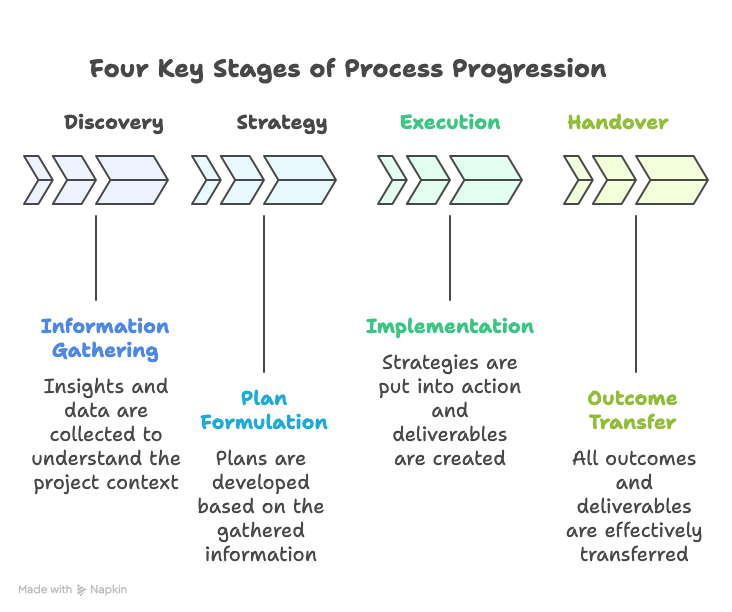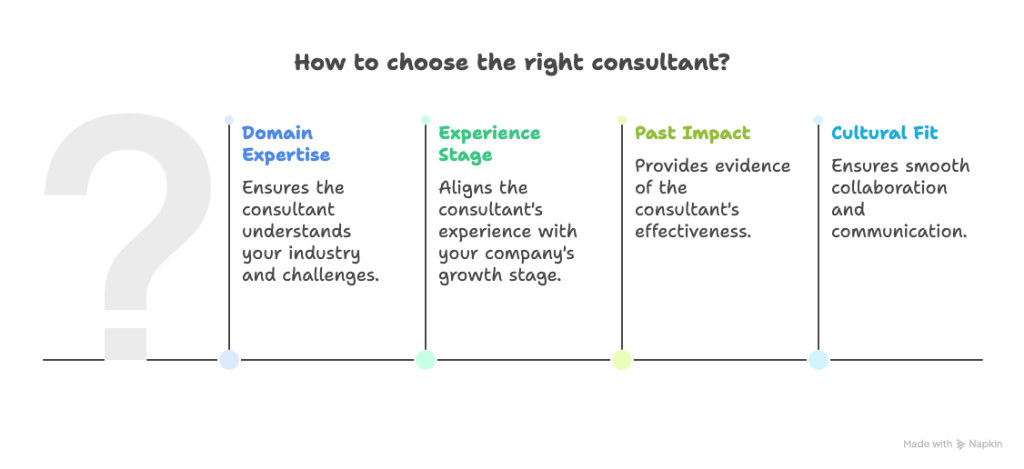Product Management Consultant: A Complete Guide to Hiring, ROI, and Success
September 29, 2025 • 9 min read

Scaling a product is never straightforward. Founders and executives often reach a stage where internal teams are stretched, priorities clash, and the roadmap feels more like a wishlist than a strategy. This is usually the point when companies start looking for outside expertise, and one of the most effective ways to get that is by working with a product management consultant.
A product management consultant brings clarity, structure, and experience into organizations that need direction but do not yet require or cannot justify a full-time executive hire. Unlike coaches or interim leaders, consultants are typically brought in to solve specific problems, uncover blind spots, and accelerate decision-making. The challenge, however, is knowing when a consultant is the right choice, what they actually do, and how to measure whether they deliver real value.
This guide walks you through everything you need to know about product management consultants, from what they do and how much they cost, to how to choose one and avoid common pitfalls. By the end, you will understand not just the role itself but also how it compares to other models like a fractional Chief Product Officer, and which option makes the most sense for your company’s stage of growth.
Key takeaways:
- A product management consultant provides targeted, project-based expertise to help companies solve product challenges and scale effectively.
- Engagements usually follow a structure of discovery, strategy, execution, and handover, with deliverables such as audits, frameworks, and roadmaps.
- Pricing models vary widely, from hourly rates to retainers and value-based contracts, but ROI should always be tied to measurable outcomes.
- Common risks include misalignment, internal resistance, and dependency, all of which can be mitigated with clear scoping and strong governance.
- Consultants differ from coaches and fractional CPOs: while consultants are project-based, a fractional CPO provides ongoing executive leadership aligned with long-term growth.
What is a product management consultant?
A product management consultant is an external expert who helps companies improve how they build, prioritize, and deliver products. They are not permanent hires. Instead, they are engaged for a set period of time or a specific project to provide guidance, frameworks, and an outside perspective.
Unlike in-house product managers, consultants are not embedded in day-to-day operations. Their role is to step back, spot patterns, identify bottlenecks, and design solutions. Compared to coaches, who focus on skill development, consultants focus on outcomes. And compared to a fractional CPO, who provides ongoing leadership, a consultant typically has a shorter, project-based engagement.
| Role | Duration | Focus | Outcome |
| Consultant | Short-term, project-based | Solve specific problems | Frameworks, roadmaps, audits |
| Coach | Ongoing | Skill development | Better PM capabilities |
| Fractional CPO | Part-time, ongoing | Strategic leadership | Aligned product and business goals |
Why and when to hire one
A product management consultant is best suited for situations where internal teams are stretched or lack specific expertise. Common triggers include:
- Struggling to align roadmap with company vision.
- Facing pressure from investors to professionalize processes.
- Expanding into new markets or customer segments.
- Experiencing friction between product, sales, and engineering.
- Preparing for rapid scaling after a funding round.
There are also cases where hiring one may not be the right choice. Very early-stage startups, for example, may lack the maturity or resources to benefit fully. In those situations, building a strong internal product culture first is often more valuable than bringing in external help.
Real-world example: From outputs to outcomes
I recently read the excellent book Escaping the Build Trap by Melissa Perri, and one story, in particular, has stuck with me because it perfectly illustrates the profound value a product consultant can bring to an organization.
Perri tells the story of one of her clients, a large, legacy financial corporation. On the surface, everything was working fine. Their teams operated like “feature factories,” delivering project after project on time and on budget. But here was the problem, and it’s an alarmingly common one: a study by Pendo found that roughly 80% of features in the average software product are rarely or never used. Despite all this activity, the company’s key business metrics simply weren’t moving. They were stuck deep in the “build trap”, focusing on output instead of outcome, which is the real value delivered to the customer and the business.
What Perri did there was a brilliant move, and it represents consulting at its best. Instead of trying to “fix” the whole organization at once, she focused on a single team as a pilot. She didn’t come with ready-made solutions; she started with a diagnosis. She identified that teams were being handed solutions to build (“build a new dashboard”) instead of problems to solve (“customers are struggling to understand their portfolio’s performance”). This build-without-validation approach is incredibly costly; the Standish Group’s CHAOS report shows that only about 35% of software projects are fully successful.
She taught them to think differently, to work with hypotheses, talk to real customers, and run small experiments before writing a single line of production code. Slowly, that pilot team became a model for the rest of the company. They not only delivered a feature that genuinely succeeded, but they could also explain why it succeeded, becoming ambassadors for a new way of working.
This story is so powerful to me because it shows that the true value of a good consultant isn’t just fixing the roadmap or introducing another framework. The value is in changing the entire mindset. This is exactly what an external consultant brings: a fresh perspective that challenges the status quo and practical tools that empower internal teams to realize their potential. This shift to outcome-driven product thinking is critical, and data from McKinsey backs this up, showing that companies with strong product management achieve 30% faster growth than their peers. It’s a perfect example of an ROI that is far deeper and more meaningful than just another feature on the list.
What does a product management consultant actually do?
The role varies by engagement, but common responsibilities include:
- Conducting a product audit to uncover gaps in process, strategy, or execution.
- Aligning leadership teams around vision and priorities.
- Building or refining the product roadmap.
- Establishing metrics and KPIs to track progress.
- Facilitating workshops with stakeholders and customers.
- Providing frameworks for prioritization and decision-making.
Typical deliverables
- Product audit reports
- Roadmaps tied to outcomes
- Prioritization frameworks
- Governance models
- Handover documentation

Engagement models and pricing
Product management consultants structure their work in different ways depending on the client’s needs.
Common models
- Hourly or daily rates: Flexible but can be expensive long-term.
- Project-based: Fixed scope and timeline, ideal for audits or roadmaps.
- Retainer: Ongoing monthly support, often used for scaling companies.
- Value-based: Pricing tied to specific outcomes (e.g., churn reduction).
- Equity or hybrid: Sometimes used with startups that cannot pay high cash rates.
Benchmark rates
- US and Western Europe: $150–$400 per hour
- Eastern Europe, LATAM, Asia: $50–$200 per hour
- Senior consultants or niche experts often charge at the top of the range
| Model | Description | Pros | Cons | Typical rates |
| Hourly or Daily Rates | Pay for time spent, often used for short-term needs. | Flexible, easy to start quickly. | Expensive long-term, unclear ROI if scope is not defined. | US & Western Europe: $150-$400/hr Eastern Europe, LATAM, Asia: $50-$200/hr |
| Project-Based | Fixed scope and timeline, ideal for audits or roadmaps. | Clear deliverables, predictable cost. | Less flexible if needs change mid-project. | Varies by project size and scope |
| Retainer | Ongoing monthly support for scaling companies. | Consistent access to expertise, long-term alignment. | Higher recurring cost, risk of underutilization. | Monthly retainers: $5k-$20k+ |
| Value-Based | Pricing tied to outcomes such as churn reduction or growth. | Aligned incentives, strong focus on results. | Harder to scope, requires trust and clear baselines. | Depends on negotiated outcomes |
| Equity or Hybrid | Compensation partially in equity, common with startups. | Lower upfront cost, shared risk/reward. | Equity dilution, may not suit every consultant. | Typically combined with reduced cash fee |
Risks and how to avoid them
Hiring a consultant is not without risks. Common pitfalls include misalignment, where a consultant introduces frameworks that do not fit the company culture; internal resistance, when teams feel threatened or dismiss outside input; and dependency, which occurs when the organization becomes too reliant on external support without building its own capabilities.
To avoid these issues, it is essential to define a clear scope and set of deliverables at the very start of the engagement so that expectations are aligned on both sides. Key stakeholders should be actively involved from day one to ensure buy-in and reduce friction. Finally, every consulting contract should include a structured transition and handover plan, which guarantees that knowledge is transferred and the organization can sustain progress once the consultant steps away.
How to choose the right consultant
Not all consultants are equal. When evaluating, look for:
- Relevant domain expertise (B2B SaaS, marketplace, consumer, etc.).
- Experience at your stage (early, growth, or enterprise).
- Evidence of past impact, ideally with metrics.
- Cultural fit and communication style.
Questions to ask
- Can you share examples of measurable results?
- How do you adapt frameworks to different contexts?
- What does a typical engagement look like?
- How do you ensure knowledge transfer after the project ends?

Measuring success and ROI
The value of a consultant should always be measured. Key metrics include:
- Faster release cycles
- Improved adoption of new features
- Increased retention or reduced churn
- Stronger alignment between product and business goals
- Higher satisfaction among internal teams
Set baselines before the engagement starts, and review results at the end. ROI can often be seen within three to six months if the scope is clear and well executed.
The future of product management consulting
The consulting landscape is evolving. Increasingly, companies expect consultants to bring expertise not only in strategy but also in data, AI-driven product ops, and industry-specific challenges. More founders are also turning to fractional leadership models, where instead of short projects they gain ongoing part-time executives who drive product growth over the long term.
Consultant vs fractional CPO: What’s the difference?
While a consultant is brought in for short-term projects, a fractional CPO provides ongoing executive-level leadership.
- Consultant: External expert solving specific problems, usually short-term.
- Fractional CPO: Part-time executive shaping long-term product vision, aligning teams, and driving growth.
For companies navigating the messy middle of scaling, a consultant can fix immediate challenges, but a fractional CPO can own the roadmap and keep strategy aligned with revenue goals.
Conclusion
A product management consultant can be a powerful ally when your product organization needs clarity, structure, and speed. They can help align teams, sharpen your roadmap, and introduce proven frameworks. But they are not a permanent solution. If your company is reaching the stage where product leadership must be sustained, not just borrowed, it may be time to consider a fractional CPO.
If your SaaS company is scaling fast and needs senior product leadership without the cost of a full-time hire, explore our fractional CPO services. We help founders reduce chaos, improve roadmap execution, and align product strategy with business growth.

Sivan Kadosh is a veteran Chief Product Officer (CPO) and CEO with a distinguished 18-year career in the tech industry. His expertise lies in driving product strategy from vision to execution, having launched multiple industry-disrupting SaaS platforms that have generated hundreds of millions in revenue. Complementing his product leadership, Sivan’s experience as a CEO involved leading companies of up to 300 employees, navigating post-acquisition transitions, and consistently achieving key business goals. He now shares his dual expertise in product and business leadership to help SaaS companies scale effectively.